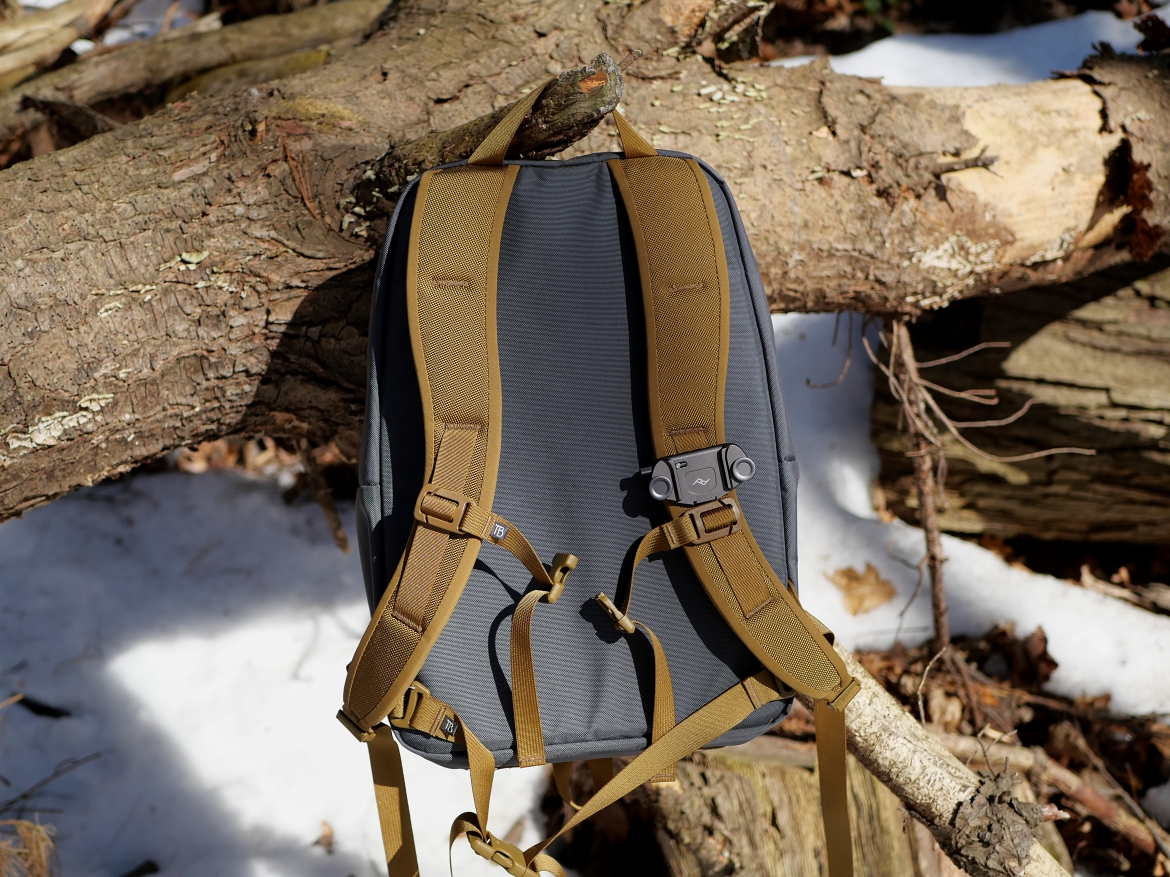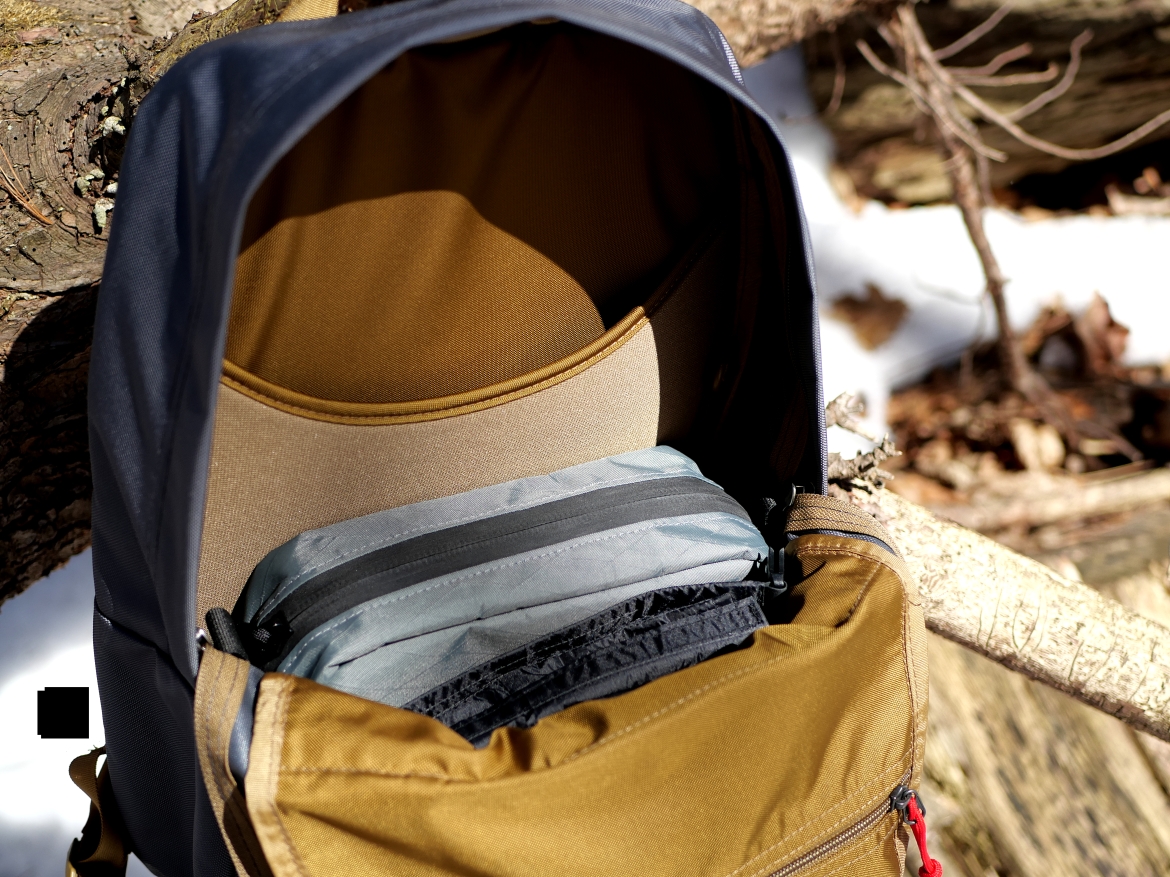With the newest release from Tom Bihn, we get taken back to a simpler time. The Paragon, both the Design Lab and Guides Editions, take cues from Tom’s decades old designs. Don’t let that fool you though; this isn’t your Jansport from kindergarten. The Paragon is a modern take, with premium materials and fixings.
If you’re used to more hyper-organized bags like the Tom Bihn Synik and Synapse, the Paragon might surprise you, for better or worse. With only three zippered compartments compared to the 6 or 7 on the aforementioned bags, the Paragon is decidedly simpler, with a price tag to match.

Tech Specs
| Imperial | Metric | |
| Height | 17.9″ | 45.5cm |
| Width | 13.4″ | 34cm |
| Depth | 6.8″ | 17.5cm |
| Weight | 1.5lbs | 672g |
| Capacity | 1200 cu. in. | 19.8L |
| Primary Materials | Ballistic 525D, YKK Zippers |
Quality and Comfort
If you’re familiar with Tom Bihn there should be no surprises here. While the Paragon is a bit of a divergence from some of the other TB offerings, most of the common design and finishing elements are in place.
At this point I’m sure TB has piles of edgeless straps sitting around and they just slap them on everything. I have no complaints about that. The edgeless straps are really comfortable and feel like a nice hug. Some people have recently started preferring the older bound straps, as they’re easier to slip on and off your shoulder, but my preference leans towards the edgeless.

This isn’t unique to these straps, but I like that they aren’t too wide. Straps that are too wide can often cut into certain parts of your body. The slightly slimmer profile also lets me run my Peak Design Capture Clip without issue, which is a must for me on most backpacks.
The backpanel itself is well padded from the interior, but has no ventilation of any sort. It’s made entirely of one piece of the bag’s primary fabric, of which the Paragon is available in a few. It’ll get sweaty in more humid climate, that’s for sure. But this is a simple pack, and a simple backpanel is okay.

The Paragon comes with a simple 1″ webbing belt that, as usual, I removed as soon as it arrived. If you really want a waist belt for a pack this size, I’d recommend upgrading to the padded 1″ straps that are available directly from Tom Bihn. However, I don’t think I’ve ever run a belt on a bag this size, and belts only really work to put load into your hips when the frame sheet (and stay) properly extends from the top of the strap attachment to the belt line. This bag doesn’t have a frame sheet or stay, so it only adds some stability if you’re running around; not any real load carriage or comfort.

The silhouette of the Paragon is decidedly rectangular, and takes up most of my 5’8, 175lb torso. While the lack of any standout shape or design elements might seem a bit boring, it really makes for an efficient use of space. It’s also pretty comfortable with no pressure points, unless you’ve really packed it poorly.
One small critique on the typical Tom Bihn quality is the exposed seam stitching in some of the corners of the interior of the bag. This is completely cosmetic. I will repeat that. This is completely cosmetic. Tom Bihn also says that this is in spec for their QA processes. Binding is typically sewn this way as well, with the binding stitch above the seam stitch, but the edge of the binding usually covers the seam stitch. In my personal opinion, this should be a QA issue, especially on a premium, expensive bag, but I’ll leave the personal decision up to you.

Organization and Access
As we’ve been mentioning, the Paragon is pleasantly simple. It only contains two zippered pockets, and a laptop sleeve. The front pocket itself has some volume, which is a nice departure from most other brands when it comes to front pocket design. You can easily stuff a small jacket in here, or a few pouches. There’s also a provide key leash. Like the main zipper, this pocket has rain flaps. Personally, I don’t like rain flaps, but rain flaps can have varying levels of success. They work okay here, but I could do without them – they limit access somewhat and can get in the way of the zipper slider.
If I had to choose between waterproof zippers, standard zippers, or standard zippers with rain flaps, I would just rain flaps last every time. The cost-benefit is not worth it to me, personally; though I imagine it rains 365 days out of the year up at Tom Bihn HQ in Seattle.

This specific variant, the Guides Edition, has all of the accoutrements you’ve come to expect from the other GE variants. Felt and nylon diamond lashing points on the front and bottom, a loop at the bottom to secure trekking poles or tripods, and of course the signature coyote webbing and zippers. It’s not for everyone, but I really enjoy the GE packs. If you don’t, there’s always the Design Lab Edition which is stripped down and more subdued.
The rain flaps on the main compartment are less of an issue, but the rain flaps do cause some issues around the close-to-90-degrees corners. They’re not the worst things in the world, but I could still do without them. Otherwise, the zippers themselves are a pleasure to use, and are generally smooth. That said, YKK #10, rather than #8, would have made a difference.

The only other zippered area on the Paragon is a top-access dump pocket on the interior of the front compartment. It extends down to the top of the exterior pocket, and no further. It’s simple, and the only real place to stash smaller items. Unlike on some other bags, there is no pocket below it, further down into the bag.

The main compartment itself is a half-zip design. I like half-zips for EDC, as it’s easier to stuff bulkier items in the bottom, and everything doesn’t potentially tumble out like it can on a full clamshell opening. This is a personal preference, and I can see this being a pro or a con for some people. That said, the half-zip design leaves the sides of the bag unobstructed, so a slim, stretch bottle pocket would have been nice to see. It would have added some functionality without changing the silhouette of the bag.
The rear of the main compartment has a nicely padded laptop sleeve. The half-moon scoop does leave the top portion unprotected, but I believe it’s a nice trade of for easy access of your laptop. It’ll easily fit anything up to and including a MBP 16. The bottom of the sleeve isn’t really elevated off of the base. There is some padding there since the sleeve itself wraps back into the seam, but there is no explicitly designed gap between the laptop and the ground. It’s better than some, and not as great as others.
The sides and base of the main compartment, and front compartment for that matter, are unlined. I’d like to Tom Bihn start lining more of their bags. It’s become expected in the wider carry community, especially when we’re talking about more premium offerings like TB. It adds value, protection of seams and fabric backings, and even sometimes a pop of color.

What’s Perfect
- Fit and finish is (mostly) great
- Availability of color and fabric options is above and beyond most other brands
- Simplicity is nice and refreshing, especially when compared to other Bihn bags
- Bigger than you may think, and holds quite a bit
- Half-zip is great for every day use

What’s Not
- Laptop sleeve isn’t truly raised
- Rain flaps are love-hate, but they can get in the way of zipper movement and access
- One extra internal pocket, bottle pocket, or small external stash pocket would add some value
- Stitching below the binding and unclipped threads in minimal spots is “in spec” but unsightly on a premium bag
- We almost always want to see bags fully lined.

Wrap Up
The past year has been an interesting time for Tom Bihn. Early on during the COVID-19 pandemic we saw that team really ramp up mask production – some of the best on the market – and help out our front line workers. This, of course, lead to a downturn in their production of bags and other softgoods. Now that we’re getting somewhat back to normal, we’ve seen regular releases from Tom Bihn, and a handful of new products like the Paragon and the Le Grand Derriere. However, one theme has remained consistent among the latest pre-orders, drops, and products: the past. While the Paragon and LGD are new products, they’re some of Tom’s old, original designs. Other production has often been around iterations or reintroductions of older TB products, like the Truck series. This is just an observation, but I do think it means that Tom Bihn is currently playing it a bit safe, and rightfully so. Most soft good industries are still recovering from a bad year, in terms of supply, workforce, and sales; and we’re not quite done yet. I’m enjoying the lookback on Tom Bihn, but I’m more excited for the future.
The Paragon GE and Design Lab editions are great, simple yet substantial bags, from one of the longest standing designers in the game. It bridges the gap between packs like the Daylight and the Synapse. The Paragon is available directly from Tom Bihn, in a wide variety of materials and colors, starting at $160 for the Design Lab Edition and $170 for the Guides Edition.

Video Hands On
Editor’s Note: The Paragon was provided by Tom Bihn as a sample for review purposes. The content of this review was not shared with Tom Bihn before publishing. Our reviews are unbiased and never modified to keep a brand happy.









